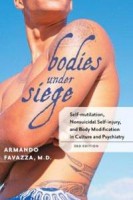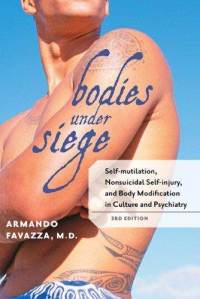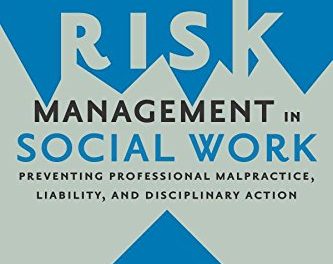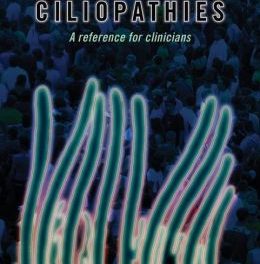 Author: Armando Favazza, M.D.
Author: Armando Favazza, M.D.
Publisher: Johns Hopkins University Press
Book Review by: Artha Hemrajani
This book, first published in 1987, is probably the first psychiatric study on self-mutilation and related behavior, and has been described by reviewers as a ‘classic and authoritative book’ on this subject.
It has been noted by people working in the press as “a pioneering work that identifies cultural and societal factors that impel and even compel people to harm themselves.”
This new edition published in 2011 contains updates and new findings from hundreds of new studies.
As someone who does not know much about mental health issues, I referred to comments on this book in professional journals and was surprised to find that it has been very well received.
For example, here is a comment found in the Journal of Nervous and Mental Disease in 2012: “Bodies under Siege is an excellent book dealing with self-mutilation in depth and breadth. It is a clinical volume that should be of use to all in the mental health field. The book is also an anthropological contribution to the understanding of what it means to be human.”
The British Journal of Psychiatry describes it as “very well written and extremely informative. Favazza has produced a refreshingly honest and objective account of self-harming behaviour. There is much to be learned from this book and, for clinicians or academics working with people who self-harm, it is an invaluable resource.”
And New Scientist commented on the 1996 edition: “The second edition of the fascinating but gruesome Bodies under Siege by Armando R. Favazza explores the various ways in which people mutilate their bodies. Favazza explores the historical background and offers insights into how and why people do truly appalling things to their limbs, heads and genitals. He pleads for understanding for a group of patients who are often seen as bizarre and repellent.”
The book is organized into three main parts, plus an epilogue.
Part I looks at mutilative beliefs, attitudes, practices and images, Shamanism, religion, self-injury, eating disorders, animals and auto-mutilation.
Part II describes in detail self-injury of body parts such as the head and its parts, the limbs, the skin and the genitals. It presents cultural and clinical cases.
Part III is entitled Insight and Treatment and has topics on understanding self-injury; the assessment, psychology and biology of self-injury; treatment; and his personal reflections.
The epilogue, entitled Body Play – My Journey has been written by Fakir Musafar, who laments that in the 15 years that have transpired since he wrote the epilogue for the second edition of this book in 1996, what started as a ‘subculture phenomenon’ then, has become a ‘mainstream tsunami’ in 2011.
He refers to visible tribal-inspired tattoos; men as well as women with fully tattooed shoulders and arms; women with tattoos on the nape of the neck, back, ankles and feet and elsewhere; extremely small waists and tight corsets; men and women wearing nose rings; doing enlarged ear lobe piercing and wearing tribal plugs, hooks and spirals. And much more. It has become more than style. It has become a means of ‘psychic expression and healing’, he points out.
“Why do we continue to alter, change, adopt, amend, revise. Reshape, refashion, restyle, revamp and refine our bodies?” he asks. There are many intents, Musafar answers.
Get the book to read them, as well as Dr. Favazza’s discoveries, comments and conclusions in this fascinating book.
Armando Favazza, M.D. a psychiatrist is an emeritus professor in the department of psychiatry at the School of Medicine at the University of Missouri in Columbia. He is a fellow of both the American Psychiatric Association and the American College of Psychiatrists. He is a co-founder of the Society for the Study of Psychiatry and Culture.
He received his undergraduate degree in anthropology from Columbia University, where he studied with the famed Margaret Mead. He received his M.D. from the University of Virginia and his M.P.H. from the University of Michigan, where he also completed his residency training in psychiatry.
In 2004 he authored another book – PsychoBible: Behavior, Religion, and the Holy Book, which presents objective data regarding commonly held misconceptions about the Bible as a whole as well as its major passages. He has written numerous articles for various professional journals and is best known for his studies of ‘cultural psychiatry’, deliberate self-harm, and religion.







